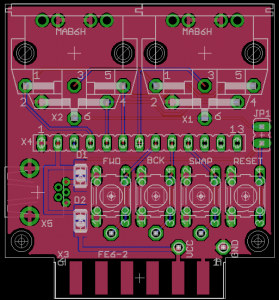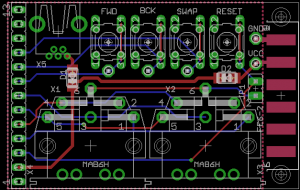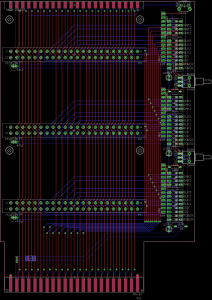
After completing the first revision of the uIEC/SD daughtercard, I grew unsatisfied with with the sole but significant shortcoming. In all applications except the C128DCR usage, the dual IEC connectors would obscure some important port of the host machine. On the VIC/C64/C64C, the connectors would prevent user port usage, while C128/C128D applications would affect video and IEC connector usage. With so many machine types affected, there was little reason to include a cassette port connector, since many of the uses would require a USB power supply.
Removing the cassette port connector would create two issues:
- The unit would cost more to produce and sell (mandatory USB power supply).
- Complexity would be increased (additional power supply to attach, additional power connection required, additional item to remember when packing unit for travel).
When considering placement options today, I happened upon a nonstandard placement idea that appears to resolve the shortcoming without undue implications.
Since it was important to retain the cassette port connector, this meant IEC jack placement must be directly opposite the cassette port jack. Any other option exhibits the initial issue. However, that left no location for the actual uIEC/SD unit itself. I realized I could orient the drive into a vertical position. Not only does this cleanly resolve the placement issue, this also removes a long standing shortcoming of the previous design. Previously, inserting or removing a card meant holding onto the entire unit so it would not push away from the user. In the new orientation, insertion and removal will require one hand.
The vertical orientation now means VIC-20, C64, C64C, and C128 users can see the top of the unit while looking at their machine. Card access is much easier.
The sole downside: With the unit now perpendicular to the daughtercard plane, enclosure mounting will pose additional challenges. However, I’m much happier with this design over the previous revision:
- IEC ports no longer restrict access to C128, C128D, VIC-20,C64, or C64C owners.
- Many owners never enclose the unit. The new revision puts the unit behind the machine and physically attaches the unit to the machine, minimizing the need for an enclosure.
- The few that do mount in an enclosure appear savvy enough to construct an extension for the uIEC/SD connector or determine an alternate connection method.
I appreciate comments and thoughts on this new design. Namely, how do people feel about a vertical drive configuration?

